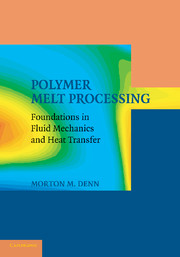Book contents
- Frontmatter
- Contents
- Preface
- 1 Polymer Processing
- 2 Fundamentals
- 3 Extrusion
- 4 Temperature and Pressure Effects in Flow
- 5 The Thin Gap Approximation
- 6 Quasi-Steady Analysis of Mold Filling
- 7 Fiber Spinning
- 8 Numerical Simulation
- 9 Polymer Melt Rheology
- 10 Viscoelasticity in Processing Flows
- 11 Stability and Sensitivity
- 12 Wall Slip and Extrusion Instabilities
- 13 Structured Fluids
- 14 Mixing and Dispersion
- Postface
- Author Index
- Subject Index
- Plate section
- References
10 - Viscoelasticity in Processing Flows
Published online by Cambridge University Press: 05 June 2012
- Frontmatter
- Contents
- Preface
- 1 Polymer Processing
- 2 Fundamentals
- 3 Extrusion
- 4 Temperature and Pressure Effects in Flow
- 5 The Thin Gap Approximation
- 6 Quasi-Steady Analysis of Mold Filling
- 7 Fiber Spinning
- 8 Numerical Simulation
- 9 Polymer Melt Rheology
- 10 Viscoelasticity in Processing Flows
- 11 Stability and Sensitivity
- 12 Wall Slip and Extrusion Instabilities
- 13 Structured Fluids
- 14 Mixing and Dispersion
- Postface
- Author Index
- Subject Index
- Plate section
- References
Summary
Introduction
Viscoelasticity will clearly have a large effect in some processing operations and little or none in others, and we require a way to discriminate between these cases. One clue follows from the linear viscoelastic experiments shown in Figures 9.2 and 9.3 and the accompanying spectral description in Equations 9.11a–b. The entangled network is able to relax at low frequencies, so the elastic contribution to the stress is negligible and the deformation is mostly dissipative (G′ 0). The stress at high frequencies cannot relax, so dissipation is negligible and the deformation is recoverable (η′ 0). The transition between these two extremes is sharp for a liquid with a single Maxwell mode and occurs in the neighborhood of λω ~ 1.ω-1 is the characteristic time for the oscillatory deformation, so we may think of the two limiting cases as representing processes that are slow and fast, respectively, relative to the characteristic time of the fluid. The transition is murkier for most polymer melts, where there are many dynamical modes, but there will be some relaxation time – a mean value like that given by Equation 9.20 or the longest relaxation time in the spectrum – such that the same criterion can be usefully applied. The ratio of the characteristic time of the fluid to the characteristic time of the process is known as the Deborah number and is usually denoted De. The time scale for the process is usually the residence time.
- Type
- Chapter
- Information
- Polymer Melt ProcessingFoundations in Fluid Mechanics and Heat Transfer, pp. 153 - 174Publisher: Cambridge University PressPrint publication year: 2008



